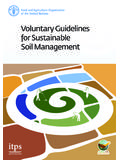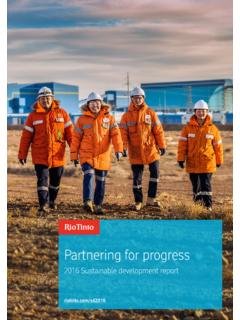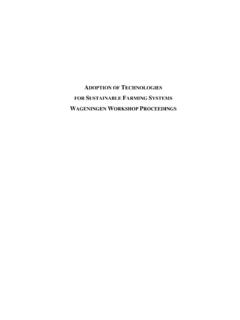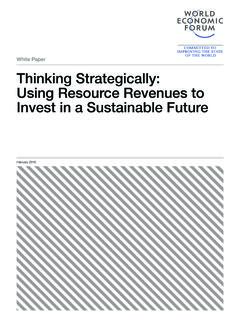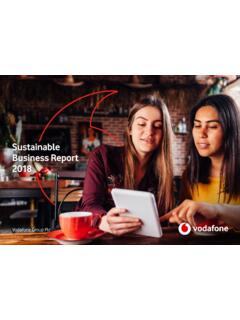Transcription of of Sustainable Procurement Practices - Saulnier Conseil
1 1020 PwC and EcoVadis in collaboration with the INSEAD Social Innovation CentreValueof Sustainable Procurement Practices A quantitative analysis of value drivers associated with Sustainable Procurement Practices2 Table of contentsExecutive summary .. 3 Quantifying the value of Sustainable Procurement .. 6 Valuation framework .. 71) Cost reduction .. 82) Risk reduction .. 123) Revenue growth .. 15 Implementation cost .. 18 Quantitative Model .. 19 Caveats and limitations .. 20 Moving forward .. 21 AppendicesAppendix I Value drivers .. 22 Appendix II Cases analysed .. 23 Bibliography .. 25 Authors .. 26 About PwC .. 26 About EcoVadis .. 27 About Insead .. 27 Value of Sustainable Procurement Practices 3 Executive summaryRelationship between sus-tainability and value crea-tion will be a key issue to be tackled over the long term.
2 The ability to express sustainability benefits in fi nancial terms is one of the key drivers needed to instil sustainability into company business models. Although it is no easy task, PwC, EcoVadis and Insead believe that it should be one of the priorities for research in this fi Procurement is a new dimension for Chief Procurement Offi cers (CPOs) who until recently based their decisions pri-marily on price, quality and time. Sustainability was mainly taken into account on a risk-based approach in line with the global move-ment towards low cost country sourcing. But how can this risk protection be quantifi ed? And what is the impact on cost reduction and the development of new offers/products?
3 The aim of this study is to help Senior Procure-ment Managers face this challenge by providing strong arguments to build a business case with top management and the CEO on the value of Sustainable Procurement . Accordingly we asked ourselves: Is Sustainable Procurement a true value creation initiative to be welcomed not only by customers but by shareholders and fi nancial markets as well? To answer this question, we analysed various case studies and interviewed Procurement executives. This brought to light strong evidence of value creation, thus bridging the gap and making a fi rst business case for Sustainable Procurement on the basis of three main Sustainable value drivers: cost reduction, risk reduction and revenue quantitative model was created by the analy-sis of the three main drivers and their respective impact on the company s annual Procurement spend, market cap and revenue.
4 Their impact was then compared to the implementation cost of a Sustainable Procurement RESULTSCOMPARED TO Sustainable Procurement PROGRAMME COSTSIMPLEMENTATION PROBABILITY1. Cost reductionReduction in total cost of ownership linked to reduced energy costs, reduced over-specifi cation, reduced consumption and reduced social and environmental compliance of total revenue per project 1Up to 6 times paybackHigh2. Risk reductionFinancial impact on brand value from bad supplier Practices ( , child labour, local pollution); economic cost of supply chain disruptions ( , noncompliance with environmental regulations)Additional direct costs as a of total revenueUp to 85 times paybackLowDecrease of 12% in market capNALow3.
5 Revenue growthAdditional revenue through innovation of eco-friendly products/services, price premium or income from recycling of total revenueUp to 58 times paybackMediumAccording to the above model, it appears that the cost reduction impact of Sustainable Procurement (on those categories where cost savings and sustainability benefi ts are aligned) outweighs the implementation costs in almost all of the cases studied.(1) This proportion has been calculated on the basis of only one project studied per company, Consequently, the cost reductions seem to be of Sustainable Procurement Practices 5programmes in high-risk countries, which would in turn protect the brand and improve the company s long-term , those conclu-sions should not be used to forecast future perfor-mance, but rather to provide some order of magnitude of the financial value of Sustainable Procurement .
6 The results could also vary considerably depending on a company s specifi c industry. Information from Procurement departments on the potential value of sus-tainable Practices for their own company is indispen-sible in order to carry out further research. However, the availability of this type of information has been extre-mely limited and will likely continue to pose a chal-lenge in the study underlines the importance of Procurement departments working on all three dimensions of value creation from Sustainable Procurement Practices and not only on cost reduction. There is a signifi cant bene-fi t for companies if procu-rement departments work closely with the marketing and R&D departments upstream on the projects.
7 In most cases, this requires a process modifi cation to involve Procurement experts in the design of new pro-ducts/services. One solu-tion could also be to provide incentives to Procurement departments to work on the three dimensions of sustai-nability value creation which could lead to higher value as well as greater potential benefi t from Procurement , there are also other dimensions of value crea-tion that should be further investigated. We can at least mention two other dimen-sions that have not been addressed in this study because their financial quantifi cation is also very challenging. The fi rst one is the human dimension since the implementation of a Sustainable procure-ment programme is a lever of attractiveness for the companies regarding their teams.
8 The second one deals with the business models transformation pro-cess. In fact if we look at the automotive sector for example, there is a move towards a functionality eco-nomy in which consumers will use cars for mobility reasons but will no more buy it. In this transforma-tion process, Procurement departments have also a key role to play to accom-pany those new business reduction also repre-sents a major benefi t for companies given the fi nan-cial consequences of a sup-ply chain incident in terms of direct and indirect growth might be more diffi cult to achieve, as it requires the procure-ment departments to work upstream in close coopera-tion with suppliers and other departments such as R&D and marketing in order to contribute to the creation of new would mean that sustai-nability-driven cost reduction alone could fund the entire initiative.
9 Allowing com-panies to benefi t from the risk management benefi ts and the potential revenue growth opportunities. In other words, the savings generated through, for example, a reduc-tion in energy consumption at the company s head offi ce in Europe could fund the suppliers CSR engagement 6 Quantifying the value of Sustainable ProcurementUntil recently, Senior Procu-rement Managers focused their initiatives primarily on three dimensions: price, quality, and time. That is not to say that the decisions taken in the Procurement department at that time were easy to implement. We have only to remember the potential challenges ari-sing, for example, from the decision to go to India as part of a low cost country sourcing now have a fourth dimension: sustainabi-lity.
10 Managing the various risks that arise from envi-ronmental and social fac-tors has never been more important. Supply chains are becoming increasingly complex; there are nume-rous elements in the supply chain that may stop com-panies from achieving their business objectives. In addi-tion to operational, logistics and customer service risks, reputational risk also needs to be taken seriously. For many organizations, signifi -cant new opportunities are emerging, particularly as markets are created for lower carbon, more Sustainable goods and services. Today, Sustainable Procurement is considered an important or critical priority by 90% of European CPOs (1).


